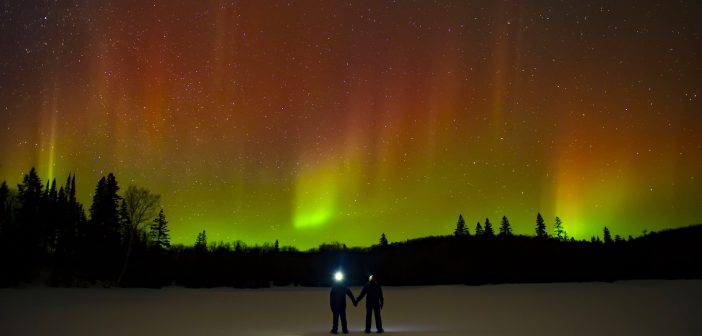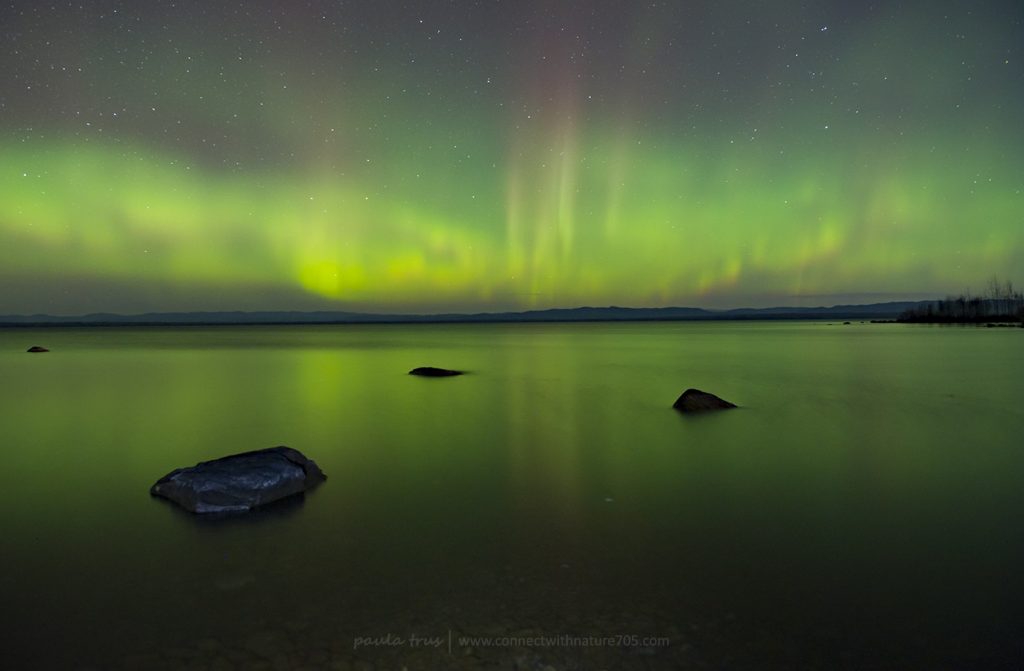The lights went out on August 14th, 2003 in Ontario and the eastern U.S. when a massive power outage hit a portion of the North American continent. Over 50 million people were affected. After the scramble for batteries, gas and cases of beer subsided, hot and sweaty Ontarians were forced outside to find relief from their stuffy homes now void of air conditioning and commuters in larger cities reluctantly camped out in public parks and in front of government buildings to wait out the black-out. Three lives were lost in Ontario that night but in the midst of tragedy and inconvenience there was beauty in the darkness. The night sky glittered, infinite stars forming a celestial canopy above the entire province.
For many it was the first time they witnessed the sky as it was created and for some, they might not have cast their eyes on such a sight again since that night.
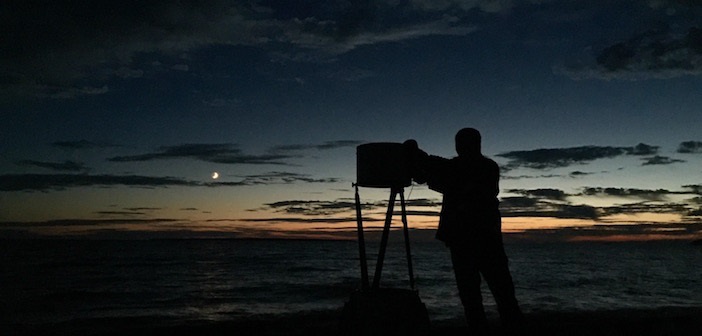
Jeffrey Deans setting up his telescope on the shores of Lake Superior Provincial Park for an evening of star gazing.
By day Jeffrey Deans is a senior IT architect with the OLG in Sault Ste. Marie, by night he is the outreach coordinator for Algoma Astronomers. Deans is leading an initiative with Lake Superior Provincial Park that if successful will achieve a Dark Sky Preserve designation and would be the first provincial park to do so. Dark Sky Preserves are assigned their designation by the Royal Astronomical Society of Canada.
A Dark Sky Preserve is an area that is kept free of artificial light –for the most part. Lake Superior Provincial Park has a total area of 1550 square kilometers of which 98% is classified as protected natural environment zones. The entire area is lit by only 65 lights on an as needed basis. Deans remarked that it is believed that Lake Superior Provincial Park is the darkest of Ontario’s parks and the darkest spot on the highway between the communities of Sault Ste. Marie and Wawa.
Criteria required to attain a Dark Sky Preserve designation includes: that the area is dark; the darkness has to be protected; the designated body implements public outreach to teach about dark skies and astronomy; outreach must also be extended to surrounding communities to encourage the protection of dark skies; and a lighting survey of the area must be completed and a strategy developed to retrofit non-compliant lighting in the area –should it exist.
According to Deans, Lake Superior Provincial Park is an ideal area for designation. “There isn’t much for this park to do,” he remarked. “This park doesn’t use lights very often. The worst offender are the comfort stations that have lights on the side of the building. They have a little bit of light spill from the windows in the building too. We can likely improve that with temporary measures and then when their lighting comes up for replacement we could put the better lights in.”
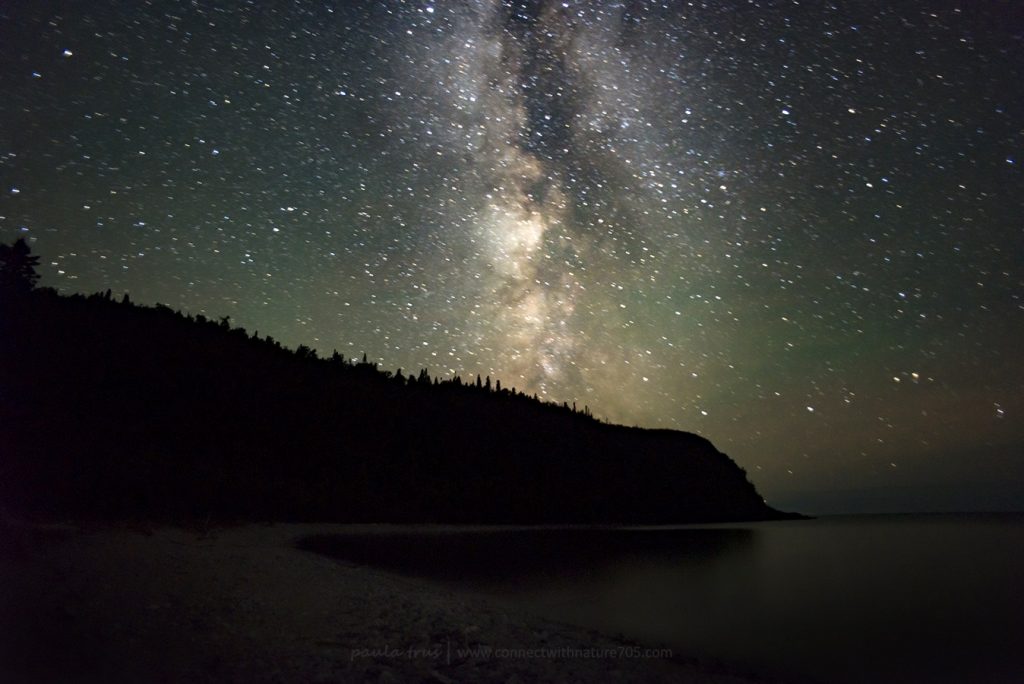
Summer milky way over the cliffs at Old Woman Bay at Lake Superior Provincial Park. Photography by Paula Trus | www.connectwithnature705.com
Light pollution is described as a “brightening of the night sky caused by street lights and other man-made sources, which has a disruptive effect on natural cycles and inhibits the observation of stars and planets.” Light pollution can be classified into four categories:
- Glare: excessive brightness that causes visual discomfort
- Skyglow: brightening of the night sky over inhabited areas
- Light trespass: light falling where it is not intended or needed
- Clutter: bright, confusing and excessive groupings of light sources
Today light pollution prevents 80% of North Americans from seeing the Milky Way.
Research demonstrates the measurable impact of light pollution upon our ecology system as well as human wellness and behaviour. Sea turtles, migratory birds and frogs are only a few animals whose patterns have been disrupted by artificial lighting.
It has been found that sea turtle hatchlings are disoriented by the bright lights found along the beaches. The sea turtles emerge from their nest and seek the ocean, guided there by the reflection of the moon on the water. Artificial lighting confuses many of the hatchlings who head off in the wrong direction and expire to predation. Millions of sea turtles die this way every year. Some coastal areas have established a ‘lights out’ ordinance when hatchlings are expected to leave their nest for the sea.
Birds require light from the moon and stars to migrate or hunt. Artificial lights sends millions of birds on a collision course into brightly lit buildings. Artificial lighting also prevents birds from identifying ideal migrating, nesting and foraging conditions.
Frog populations “worldwide are in decline due to a variety of environmental stressors. As many frog species are nocturnal, they are especially susceptible to harm from light pollution. Scientists have also discovered that artificial light influences the mating call of many species of tree frogs. In areas that are highly lit, male tree frogs stop or lessen their mating call. And if the males aren’t calling, the females aren’t reproducing.”
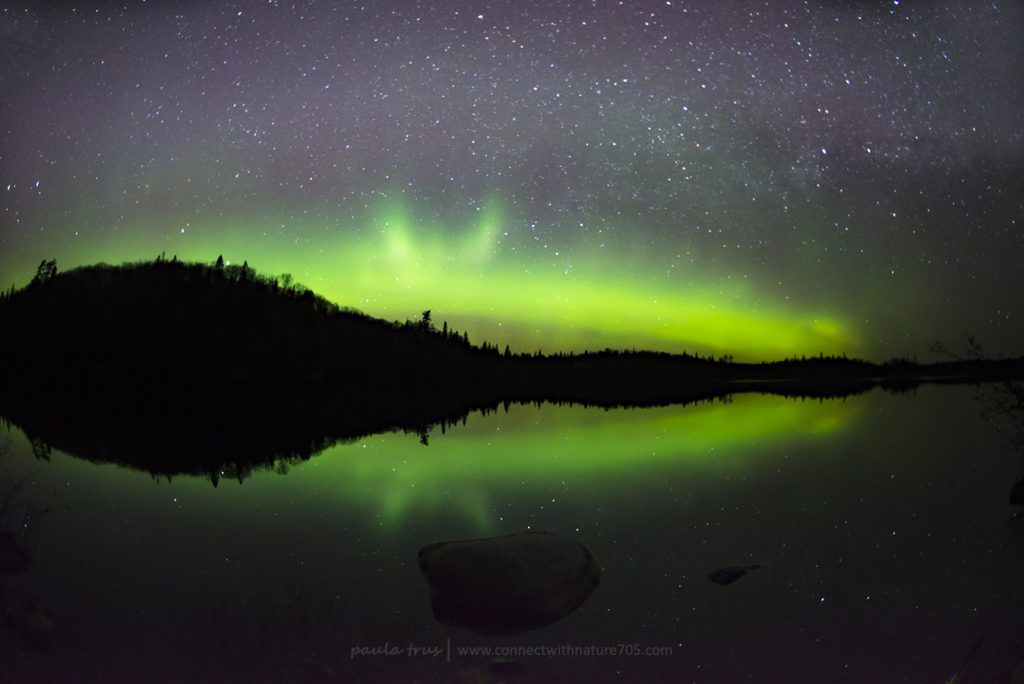
Spring aurora, the aurora looks like an outline of the Mishipeshu Pictograph. Lake Mijinemungshing in Lake Superior Park. Photography by Paula Trus | www.connectwithnature705.com
Of human behaviour, Deans stated that increased lighting may actually increase crime in an area. Citing various research Deans added, “Criminals are afraid of the dark. Everyone is afraid of the dark. When you see people breaking into a house in the daytime nobody thinks a crime is happening. Criminals have reported that people wave as they are driving by while they are breaking in somewhere. Your guard is down in the light and criminals get away with it.”
It has been noted that some crime like graffiti or vandalism thrive under night lighting.
Perhaps the most researched effect that light pollution has on humans is the impact of artificial lighting on our sleep patterns. Not only street and outdoor lighting but an influx of electronic devices in our home has inclined many people to poor sleeping habits. Artificial light interrupts “our natural circadian rhythms…and as a result, our brain produces less of the hormone melatonin, which is produced in the absence of light and helps regulate sleep”.
Deans efforts to preserve the dark skies extends to communities in the Algoma District. He hopes to work with town officials in Wawa and Sault Ste. Marie to increase awareness about the value of dark sky compliant lighting and the necessity and benefits of dark skies. Though Deans has yet to pursue serious discussions in the town of Wawa he believes that the town will be receptive. “They are a smaller community and they’re very in touch with nature.”
Deans has been speaking with Sault Ste. Marie’s City Council and is hoping to establish an area in the city that is reasonably protected from light pollution or at least direct light that could be designated as an Urban Sky Park. Deans would like to utilize the area for public outreach. As with Lake Superior Provincial Park, the City would have to follow the criteria required of an Urban Sky Park which includes the establishment of light pollution abatement by-laws. The City has put this thought on ice for the time being.
“Light pollution abatement by-laws are pretty much the same across North America,” remarked Deans. “The concept is to grandfather them in because forcing change is too disruptive and it’s too expensive.”
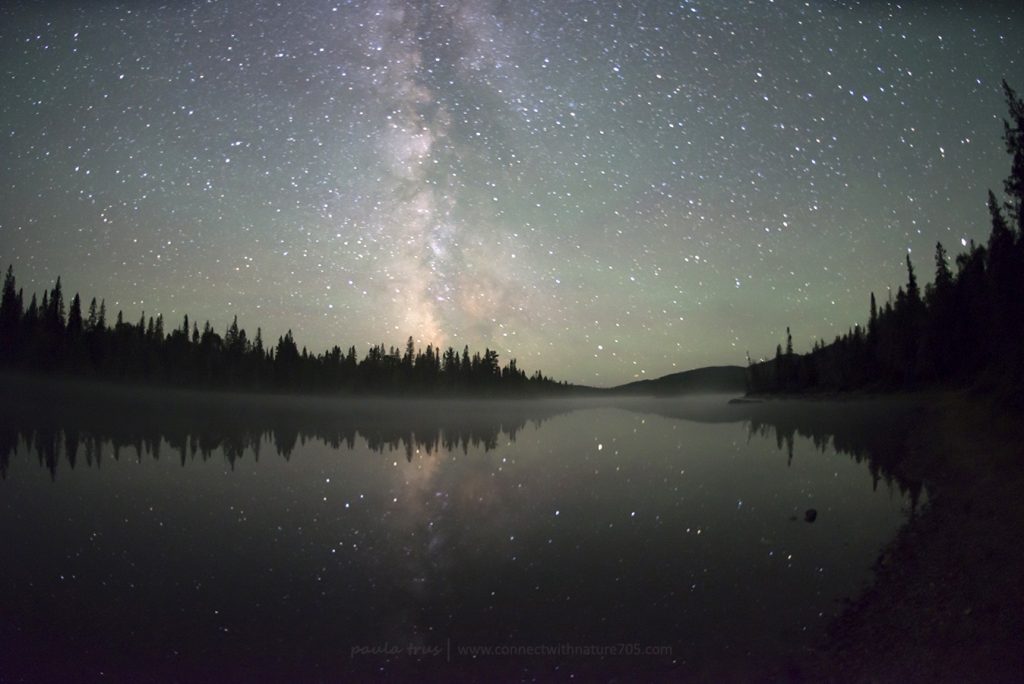
Summer dark skies. Rabbit Blanket Lake in Lake Superior Provincial Park. Photography by Paula Trus | www.connectwithnature705.com
In 2015 the City of Sault Ste. Marie kicked off a LED Road Lighting project that will see the conversion of 9,050 street lights by the end of October 2016. Though it was difficult to obtain an accurate number it is worth noting that the number of lights regulated by the PUC do not include parking lot lights or other lights erected on business properties.
Jiordan Zin, communications person for the Sault Ste. Marie PUC, remarked of the project, “All the street lights will be converted to LED and they are dark sky compliant. They have shades on them that try to reduce backlight and glare. It’s a clear light- it looks almost white.”
Deans credits the PUC for installing shades that are full or partial cut-offs which helps with directing the light down to the ground but took issue with the brightness of the lighting. “The problem is that they are too white and too bright. There is approximately 250% more light coming out of them than before. And even though that light is controlled and going down to the ground, that light has a greater tendency to reflect.”
Zin stated that the PUC has not received any negative feedback from the public regarding the LED street lights. He added, “There have been some people that were concerned that there is a much sharper cut-off and the street light isn’t spilling into their yard anymore. But at the same time, people complained about the spill-over in their yards previous to the switch to LED. In my own experience I like it. I feel like I can see further and what I see is clearer.”
According to Zin the project addresses energy efficiency and decreases costs to the ratepayer. “Once the project is paid off this will have almost one million dollars in energy savings for the City every year. As the price of electricity goes up so will our savings. It makes sense for the City. Not to mention that there is a 50% reduction in maintenance costs. And LED lasts longer.”
Zin elaborated that the new LED lighting system provided an automatic control system that allows PUC crews to know when issues arise with individual lights –such as a light not going off during the daytime.
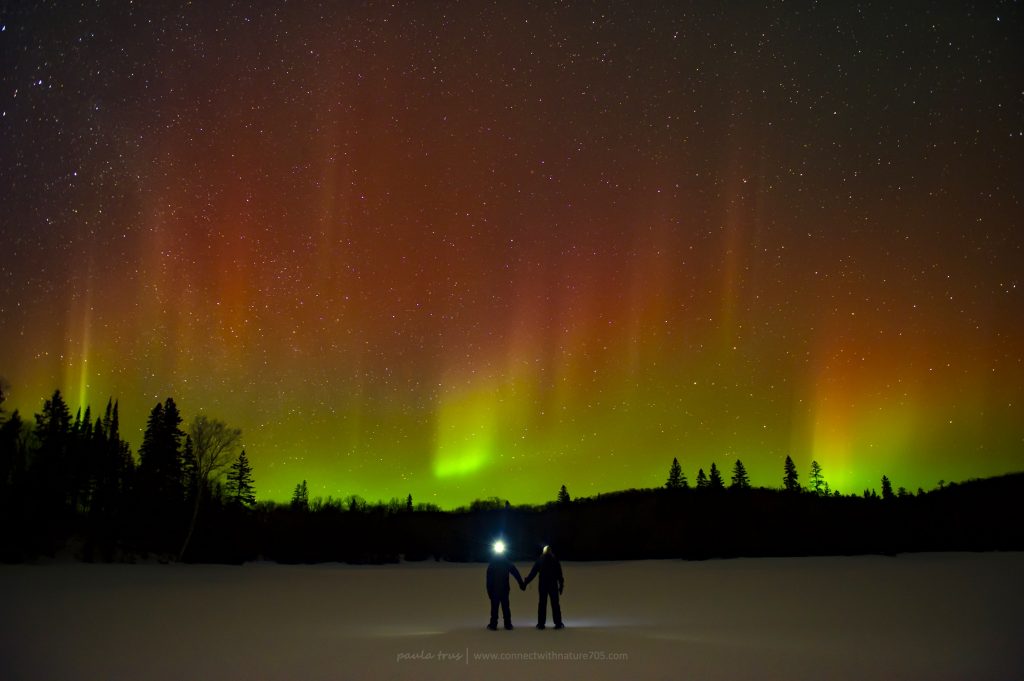
Late winter, we stayed out at -20C on a winter camping expedition. Crescent Lake Aurora in Lake Superior Provincial Park. Photography by Paula Trus | www.connectwithnature705.com
Using a sky quality meter, measures the darkness of the sky by juxtaposing the stars to the depth of blackness in the sky. Within the last year, the darkness of the sky above Deans’ driveway in Sault Ste. Marie decreased by 100%. Deans attributes this to having a long burnt out bulb replaced in a street light along his property line. However, when Dean measures the star lit sky above Lake Superior Provincial Park, the blackness increase by almost 800%.
People living within the Algoma District may be wondering about the impact of industrial wind turbines on dark skies and dark sky preserve designation. The North Frontenac Dark Sky Preserve was the first dark sky designation in a municipality in Canada. However, the development of a nearby wind farm has threatened that status.
“North Frontenac has a designated observation area and they were unable to protect that from a wind turbine that has blinking lights on it less than a kilometer away. The area has been ruined. North Frontenac had no control over that. Industrial Wind Turbines are under provincial jurisdiction. The province wrote a whole bunch of laws that can supersede any municipal by-laws and basically most of those laws can wipe out any local resistance to them. It’s a big shock that the Ontario government did that. Why did they have to put a wind farm right there? Why couldn’t they put it five kilometers away from there where it wouldn’t have been a problem?” stated Deans.
However, Deans isn’t worried about the Bow Lake Wind Farm located on the perimeter of the south end of the park nor is he worried about further development.
“Lights on industrial wind turbines are controlled by Transport Canada,” stated Deans. “The trick is to make sure they are lit to the law and not in excess. They do not need lights on every single turbine. Lights have to be a certain brightness and there are intelligent lights that will adjust brightness according to weather conditions.”
Currently the application for Dark Sky Preserve designation is in review by the park. It is hoped that the application will be approved in time for the re-opening of the park on the May long weekend in 2017.
“Tourism operators see this as a good idea,” remarked Deans. “There is no cost to them and it’s another reason to come to this area. Every little bit can help.”

